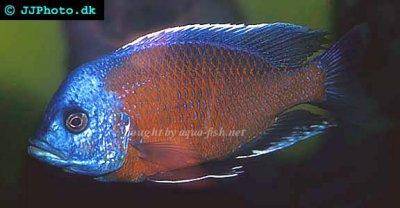Red Fin - Copadichromis borleyi
Scientific name: Copadichromis borleyi
Common name: Red Fin
Family: Cichlidae
Usual size in fish tanks: 15 - 18 cm (5.91 - 7.09 inch)
014
Recommended pH range: 8 - 8.5
Recommended water hardness: 12 - 15°N (214.29 - 267.86ppm)
0°C 32°F30°C 86°F
Recommended temperature range: 24 - 27 °C (75.2 - 80.6°F)
The way how these fish reproduce: Spawning
Where the species comes from: Africa
Temperament to its own species: peaceful
Temperament toward other fish species: peaceful
Usual place in the tank: Middle levels
Short description
Copadichromis borleyi is a classic Lake Malawi utaka (open-water hap) known for plankton-feeding and relatively calm temperament. Males develop a metallic blue head with orange–red body and fin highlights—especially in the Kadango “Red Fin” locale—while females are silvery to beige with orange-red fins. Keep a harem (1 male with 3–5 females) in a roomy Malawi setup: open swimming space in mid/upper water and rock piles for retreats. Peaceful for a hap, but males become territorial when breeding.
Origin
Endemic to Lake Malawi (Africa), where it occupies rocky shorelines and adjacent open water. Fish hover in midwater to pick zooplankton and descend to the rocks to spawn.
Food and feeding
A natural planktivore. Provide high-quality cichlid flakes/granules for Malawians, plus regular small portions of foods that mimic zooplankton: mysis, krill micro, brine shrimp, daphnia, cyclops. Add spirulina or other algae-based foods for color and gut health. Avoid fatty mammalian meats and minimize very rich foods to reduce the risk of Malawi bloat.
Sexing
Adult males are larger and far more colorful, often with extended dorsal/anal tips and pronounced egg-spots on the anal fin. Females remain smaller, silvery/beige, frequently with orange-red in the fins (especially in “Red Fin” forms).
Breeding
A maternal mouthbrooder. The male courts over a flat rock or small clearing near the rocks; the female lays and immediately takes eggs into her mouth. Incubation lasts about 3–4 weeks, after which the female releases robust fry. Start fry on baby brine shrimp, finely crushed flakes, or high-quality micro-granules. For best results, isolate holding females so they are not harassed.
Lifespan
With excellent care expect 8–12 years.
Behavior & compatibility
Generally peaceful hap that mixes well with other non-aggressive Malawi haps and Aulonocara. Avoid very aggressive mbuna and species with similar male coloration that could trigger rivalry in smaller tanks. Keep only one mature male per tank unless the aquarium is very large with multiple territories.
Tank requirements
- Tank size: minimum ~300 L (120 cm length) for a harem; larger preferred.
- Aquascape: open midwater lanes for schooling/swimming, plus rock piles/caves for security and spawning sites.
- Water: hard, alkaline; 24–27 °C; strong filtration and low nitrate with steady weekly water changes.
Notes on identification
“Red Fin” typically refers to the Kadango locale of C. borleyi. Other locales (e.g., Likoma, Nkhata Bay) show differences in body hue and fin coloration; all share the utaka body shape and midwater habits.
Keep 1 male with 3–5 females for natural behavior and reduced aggression. The male will display vivid colors and court the females over flat rocks or clearings.
Provide broken sightlines with rock piles so females can retreat when not receptive. In larger aquaria, more than one harem may be possible if territories are separated by structures.
Remove surplus males or relocate subdominant ones if they are being harassed, as C. borleyi males rarely tolerate rivals in confined tanks.
Pictures
Bought by aqua-fish.net from jjphoto.dk.




 Thread-finned
Thread-finned  Acara
Acara  Yellow
Yellow  Patrick's
Patrick's  Blue
Blue  Green
Green  Acara
Acara  White
White  Compressed
Compressed  Pastel
Pastel  Midas
Midas  Red
Red  Bluemouth
Bluemouth  False
False  African
African  Agassiz's
Agassiz's  Banded
Banded  Yellow
Yellow  Cockatoo
Cockatoo  Blue
Blue  Blackstripe
Blackstripe  Highfin
Highfin  Redstripe
Redstripe  Threadfinned
Threadfinned  Macmaster’s
Macmaster’s  Panda
Panda  Norbert’s
Norbert’s  Blue
Blue  Thin-line
Thin-line  Three-striped
Three-striped  Viejita
Viejita  Flier
Flier  Archocentrus
Archocentrus  Convict
Convict  Seven
Seven  Spiny
Spiny  Oscar
Oscar  Sunshine
Sunshine  Chitande
Chitande  Firebird
Firebird  Midnight
Midnight  Lake
Lake  Sunshine
Sunshine  Aulonocara
Aulonocara  Nyasa
Nyasa  Ruby
Ruby  Grants
Grants  Aulonocranus
Aulonocranus  Chameleon
Chameleon  Benitochromis
Benitochromis  Orinoco
Orinoco  Yellow
Yellow  Brichard’s
Brichard’s  Guenther’s
Guenther’s  Southern
Southern  Cichla
Cichla  Peacock
Peacock  Chiseltooth
Chiseltooth  Bolivian
Bolivian  Red
Red  Many-pointed
Many-pointed  Jack
Jack  Red
Red  Three
Three  Keyhole
Keyhole  Azureus
Azureus  Jackson’s
Jackson’s  Crenicichla
Crenicichla  Honduran
Honduran  Blue-eye
Blue-eye  Afra
Afra  Frontosa
Frontosa  Slender
Slender  Malawi
Malawi  Chequerboard
Chequerboard  Checkerboard
Checkerboard  Malawi
Malawi  Ectodus
Ectodus  Tanganyika
Tanganyika  Canara
Canara  Green
Green  Rostratus
Rostratus  Pearl
Pearl  Geophagus
Geophagus  Yellowhump
Yellowhump  Suriname
Suriname  Redhump
Redhump  Red
Red  Dority’s
Dority’s  Argentine
Argentine  Burton’s
Burton’s  Victoria
Victoria  Haplochromis
Haplochromis  Jewel
Jewel  Banded
Banded  Lifalili
Lifalili  Lowland
Lowland  Texas
Texas  Pantano
Pantano  Severum
Severum  Banded
Banded  Severum
Severum  Rainbow
Rainbow  Parrot
Parrot  Chocolate
Chocolate  Brown
Brown  Marlieri
Marlieri  Golden
Golden  Striped
Striped  Masked
Masked  Konye
Konye  Blue
Blue  Trewavas
Trewavas  Electric
Electric  Dwarf
Dwarf  Redbreast
Redbreast  Lamprologus
Lamprologus  Gold
Gold  Greenface
Greenface  Mayan
Mayan  Aurora
Aurora  Blue
Blue  William’s
William’s  Zebra
Zebra  Malawi
Malawi  Blue
Blue  Blue
Blue  Mbuna
Mbuna  Parallel
Parallel  Purple
Purple  Flag
Flag  Bolivian
Bolivian  Ram
Ram  Basket
Basket  Haitian
Haitian  Zebra
Zebra  Striped
Striped  Neolamprologus
Neolamprologus  Brevis
Brevis  Fairy
Fairy  Neolamprologus
Neolamprologus  Cylindricus
Cylindricus  Hecq’s
Hecq’s  Neolamprologus
Neolamprologus  Lemon
Lemon  Mustax
Mustax  Daffodil
Daffodil  Six-bar
Six-bar  Five-bar
Five-bar  Marbled
Marbled  Giraffe
Giraffe  Blue
Blue  Sulphurhead
Sulphurhead  Wolf
Wolf  Jaguar
Jaguar  Blue
Blue  Marakeli
Marakeli  Madagascar
Madagascar  Pinstripe
Pinstripe  Pelmatochromis
Pelmatochromis  Kribensis
Kribensis  Striped
Striped  Red
Red  Deepwater
Deepwater  Fenestratus
Fenestratus  Nichols’
Nichols’  Southern
Southern  Bumble
Bumble  Demason’s
Demason’s  Slender
Slender  Red
Red  Mbuna
Mbuna  Malawi
Malawi  Kenyi
Kenyi  Powder
Powder  Altum
Altum  Angelfish
Angelfish  Angelfish
Angelfish  East
East  Juba
Juba  Earth
Earth  Electric
Electric  Azure
Azure  Lionhead
Lionhead  Discus
Discus  Blue
Blue  Red
Red  Zebra
Zebra  Brichard’s
Brichard’s  Blue
Blue  Firemouth
Firemouth  Zebra
Zebra  Yellow
Yellow  Blue
Blue  Dwarf
Dwarf  Blunthead
Blunthead  The
The  White
White  Twoband
Twoband  Fenestratus
Fenestratus  Window
Window  Tailbar
Tailbar  Black
Black  Redhead
Redhead  Oaxaca
Oaxaca  Xenotilapia
Xenotilapia